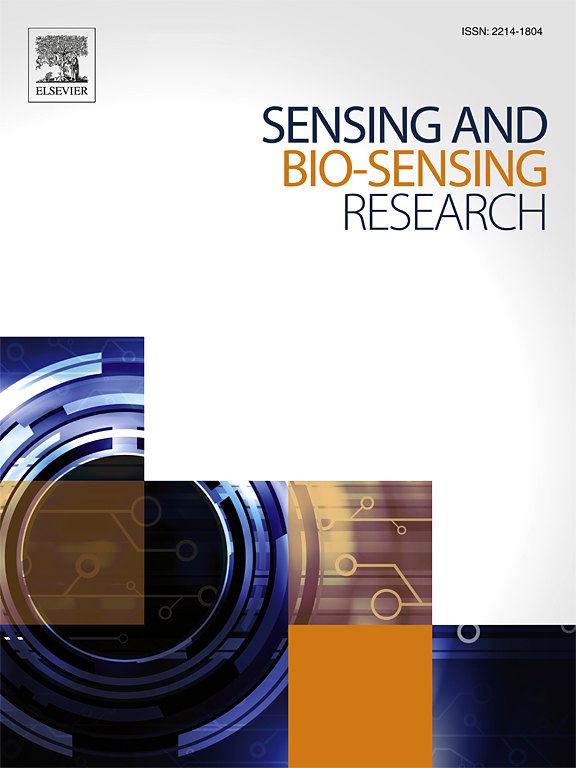A small library crRNA-enhanced CRISPR-Cas12a system for ultrasensitive point-of-care test of hantavirus M gene
IF 4.9
Q1 CHEMISTRY, ANALYTICAL
引用次数: 0
Abstract
The integration of CRISPR-Cas systems with isothermal nucleic acid amplification (INA) holds transformative potential for point-of-care diagnostics, yet technical challenges such as limited sensitivity, cross-contamination risks, and incompatibility between amplification and detection phases hinder their clinical adoption. Here, we present a novel small library CRISPR/Cas12a crRNA (SLCC) platform for ultrasensitive detection of the hantavirus M gene, a conserved target critical for diagnosing hemorrhagic fever with renal syndrome (HFRS). The SLCC platform incorporates three key innovations: machine learning-guided crRNA design to target highly conserved viral regions; multi-crRNA collaborative signal amplification to enhance Cas12a's collateral cleavage activity, and a single-tube workflow integrating reverse transcription, recombinase polymerase amplification (RT-RPA), and CRISPR detection. Experimental validation demonstrated that the combinatorial six-crRNA strategy achieved an 85-fold improvement in sensitivity over single-crRNA systems (limit of detection (LoD): 0.086 pM vs. 7.31 pM for DNA of amplification). The optimized one-step RT-RPA/CRISPR-Cas12a workflow reduced assay time, while maintaining high specificity, as evidenced by concordant results with clinical samples and negligible cross-reactivity against SARS-CoV-2, HBV, and mycoplasma pneumoniae. Notably, the platform achieved a 42.29-fold lower LoD for RNA detection compared to single-crRNA CRISPR-Cas system, with fluorescence signal amplification plateauing within 45 min. The SLCCA platform integration of RNA reverse transcription amplification and Cas12a enzymatic cleavage within a single-tube workflow, combined with lateral flow strip-based signal readout, which achieves a sensitivity of 500 pM for RNA detection, demonstrating a 10–20-fold enhancement in the LoD compared to single-crRNA systems CRISPR-Cas diagnostic approaches. The advancements in the small library crRNA strategy address critical barriers in CRISPR-based diagnostics by offering a convenient and field-deployable solution for rapid, highly sensitive pathogen detection in resource-limited settings. This study establishes SLCC as a versatile framework that can adapt to emerging infectious disease surveillance and point-of-care applications.
用于汉坦病毒M基因超灵敏即时检测的小文库crrna增强CRISPR-Cas12a系统
CRISPR-Cas系统与等温核酸扩增(INA)的整合在护理点诊断方面具有变革性潜力,然而,诸如有限的灵敏度、交叉污染风险以及扩增和检测阶段之间的不兼容性等技术挑战阻碍了它们的临床应用。在这里,我们提出了一种新的小文库CRISPR/Cas12a crRNA (SLCC)平台,用于超灵敏检测汉坦病毒M基因,汉坦病毒M基因是诊断肾综合征出血热(HFRS)的一个保守靶点。SLCC平台包含三个关键创新:机器学习引导的crRNA设计靶向高度保守的病毒区域;多crrna协同信号扩增以增强Cas12a的侧切活性,以及整合逆转录、重组酶聚合酶扩增(RT-RPA)和CRISPR检测的单管工作流程。实验验证表明,与单crrna系统相比,组合6 crrna策略的灵敏度提高了85倍(扩增DNA的检测限(LoD): 0.086 pM vs. 7.31 pM)。优化后的一步RT-RPA/CRISPR-Cas12a工作流程缩短了检测时间,同时保持了高特异性,与临床样品的结果一致,对SARS-CoV-2、HBV和肺炎支原体的交叉反应性可以忽略。值得注意的是,与单crrna CRISPR-Cas系统相比,该平台的RNA检测LoD降低了42.29倍,荧光信号扩增在45分钟内达到平台化。SLCCA平台将RNA逆转录扩增和Cas12a酶切在单管工作流程中集成,结合基于侧流条带的信号读出,实现了500 pM的RNA检测灵敏度。与单crrna系统CRISPR-Cas诊断方法相比,LoD增强了10 - 20倍。小文库crRNA策略的进步解决了基于crispr诊断的关键障碍,为资源有限的环境下快速、高灵敏度的病原体检测提供了方便和可现场部署的解决方案。本研究建立了SLCC作为一个通用框架,可以适应新出现的传染病监测和护理点应用。
本文章由计算机程序翻译,如有差异,请以英文原文为准。
求助全文
约1分钟内获得全文
求助全文
来源期刊

Sensing and Bio-Sensing Research
Engineering-Electrical and Electronic Engineering
CiteScore
10.70
自引率
3.80%
发文量
68
审稿时长
87 days
期刊介绍:
Sensing and Bio-Sensing Research is an open access journal dedicated to the research, design, development, and application of bio-sensing and sensing technologies. The editors will accept research papers, reviews, field trials, and validation studies that are of significant relevance. These submissions should describe new concepts, enhance understanding of the field, or offer insights into the practical application, manufacturing, and commercialization of bio-sensing and sensing technologies.
The journal covers a wide range of topics, including sensing principles and mechanisms, new materials development for transducers and recognition components, fabrication technology, and various types of sensors such as optical, electrochemical, mass-sensitive, gas, biosensors, and more. It also includes environmental, process control, and biomedical applications, signal processing, chemometrics, optoelectronic, mechanical, thermal, and magnetic sensors, as well as interface electronics. Additionally, it covers sensor systems and applications, µTAS (Micro Total Analysis Systems), development of solid-state devices for transducing physical signals, and analytical devices incorporating biological materials.
 求助内容:
求助内容: 应助结果提醒方式:
应助结果提醒方式:


